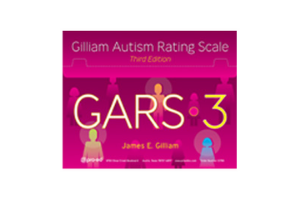Author:
James E. Gilliam
Overview:
A rating scale to help identify and diagnose autism in children and young adults
Age Range:
Individuals 3–22 years old
Administration:
Paper-and-pencil
Scoring Option:
Manual scoring
Completion Time:
5–10 minutes
Scoring Options:
Manual scoring
Publication Date:
2013
The Gilliam Autism Rating Scale, now in its third edition, is one of the most widely used instruments for the assessment of Autism Spectrum Disorder in the world. The GARS-3 assists teachers, parents, and clinicians in identifying autism in individuals and estimating its severity. Items on the GARS-3 are based on the 2013 diagnostic criteria for autism spectrum disorder adopted by the APA and published in the Diagnostic and Statistical Manual of Mental Disorders–Fifth Edition (DSM-5). The GARS-3 yields standard scores, percentile ranks, severity level, and probability of Autism.
The instrument consists of 56 clearly stated items describing the characteristic behaviors of persons with autism. The items are grouped into six subscales: Restrictive/Repetitive Behaviors, Social Interaction, Social Communication, Emotional Responses, Cognitive Style, and Maladaptive Speech.
New Features of the GARS-3
- Items and subscales reflect DSM-5 diagnostic criteria for Autism Spectrum Disorder.
- Forty-four new items were added to the GARS-3.
- All six subscales have been empirically determined to be valid and sensitive for identification of children with ASD.
- Normative data (N = 1,859) were collected in 2010 and 2011.
- Demographic characteristics of the normative sample are keyed to those reported by U.S. Bureau of the Census, 2011.
- An interpretation guide in the Examiner’s Manual allows the examiner an easy and efficient method for assessing the probability of autism spectrum disorder and the severity of the disorder.
- A diagnostic validation form is included for insuring that test results meet DSM-5 criteria for autism spectrum disorder.
Reliability and Validity
- Internal consistency (content sampling) reliability coefficients for the subscales exceed .85 and the Autism Indexes exceed .93.
- Test-retest (time sampling) reliability coefficients exceed .80 for subscales and .90 for the Autism Indexes.
- Interrater reliability intraclass coefficients exceed .80 and .84 for the Autism Indexes.
- Correlations of the GARS-3 scores with those of other well-known diagnostic tests for autism are large or very large in magnitude.
- All new validity studies show that the test results are valid for a wide variety of subgroups, as well as for the general population.
- Binary classification studies indicate that the GARS-3 is able to accurately discriminate children with autism spectrum disorder from children without autism (i.e., sensitivity = .97, specificity = .97, ROC/AUC = .93.
- Confirmatory and exploratory factor analyses demonstrate the theoretical and empirical validity of the subscales.
- Other validity evidence is provided in the manual.





